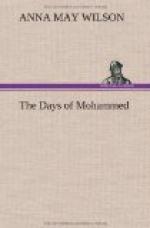“What thoughts better than the thoughts of a Persian? None. Friend, think you not so?”
The words were spoken in the Persian dialect, and the priest looked up in surprise, to see a ruddy-faced man smiling down upon him from the back of a tall, white Syrian camel. He wore the jubbeh, or cloak, the badge of the learned in the Orient; his beard was turning slightly gray, and his eyes were keen and twinkling.
“One question mayhap demands another,” returned Yusuf. “How knew you that I am a Persian? I no longer wear Persian garb.”
“What! Ask an Arab such a question as that!” said the other, smiling. “Know you not, Persian, that we of the desert lands are accustomed to trace by a mark in the sand, the breaking of a camel-thorn, things as difficult? The stamp of one’s country cannot be thrown off with one’s clothes. Nay, more; you have been noted as one learned among the Persians.”
Yusuf bent his head in assent. “Truly, stranger, your penetration is incomprehensible,” he said, with a touch of sarcasm.
“No, no!” returned the other, good-humoredly; “but, marking you out for what you are, I thought your company might, perchance, lessen the dreariness of the way. I am Amzi, the Meccan. Some call me Amzi the rich Meccan; others, Amzi the learned; others, Amzi the benevolent. For myself, I pretend nothing, aspire to nothing but to know all that may be known, to live a life of ease, at peace with all men, and to help the needy or unfortunate where I may. More than one stranger has not been sorry for meeting Amzi the benevolent, in Mecca. Have you friends there?”
“None,” said Yusuf. “Yet there is a tradition among our people that the Guebres at one time had temples even in the land of Arabia. Have you heard aught of it?”
“It is said that at one time fire-temples were scattered throughout this land, each being dedicated to the worship of a planet; that at Medina[2] itself was one dedicated to the worship of the moon and containing an image of it. It is also claimed that the fire-worshipers held Mecca, and there worshiped Saturn and the moon, from whence comes their name of the place—Mahgah, or moon’s place. The Guebres also hold here that the Black Stone is an emblem of Saturn, left in the Caaba by the Persian Mahabad and his successors long ago. But, friend, Persian influence has long since ceased in El Hejaz. Methinks you will find but few traces of your country-people’s glory there.”
“It matters not,” returned the priest. “The glory of the fire-worshipers has, so far as Yusuf is concerned, passed away. Know you not that before his eyes the sacred fire,[3] kept alive for well-nigh one thousand years, went out in the supreme temple ere he left it? May the great Omniscient Spirit grant that Persia’s idolatries will die out in its ashes!”
“And think you that there is no idolatry in Mecca? Friend, believe me, not a house in Arabian Mecca which does not contain its idol! Not a man of influence who will start on an expedition without beseeching his family gods for blessing!”




